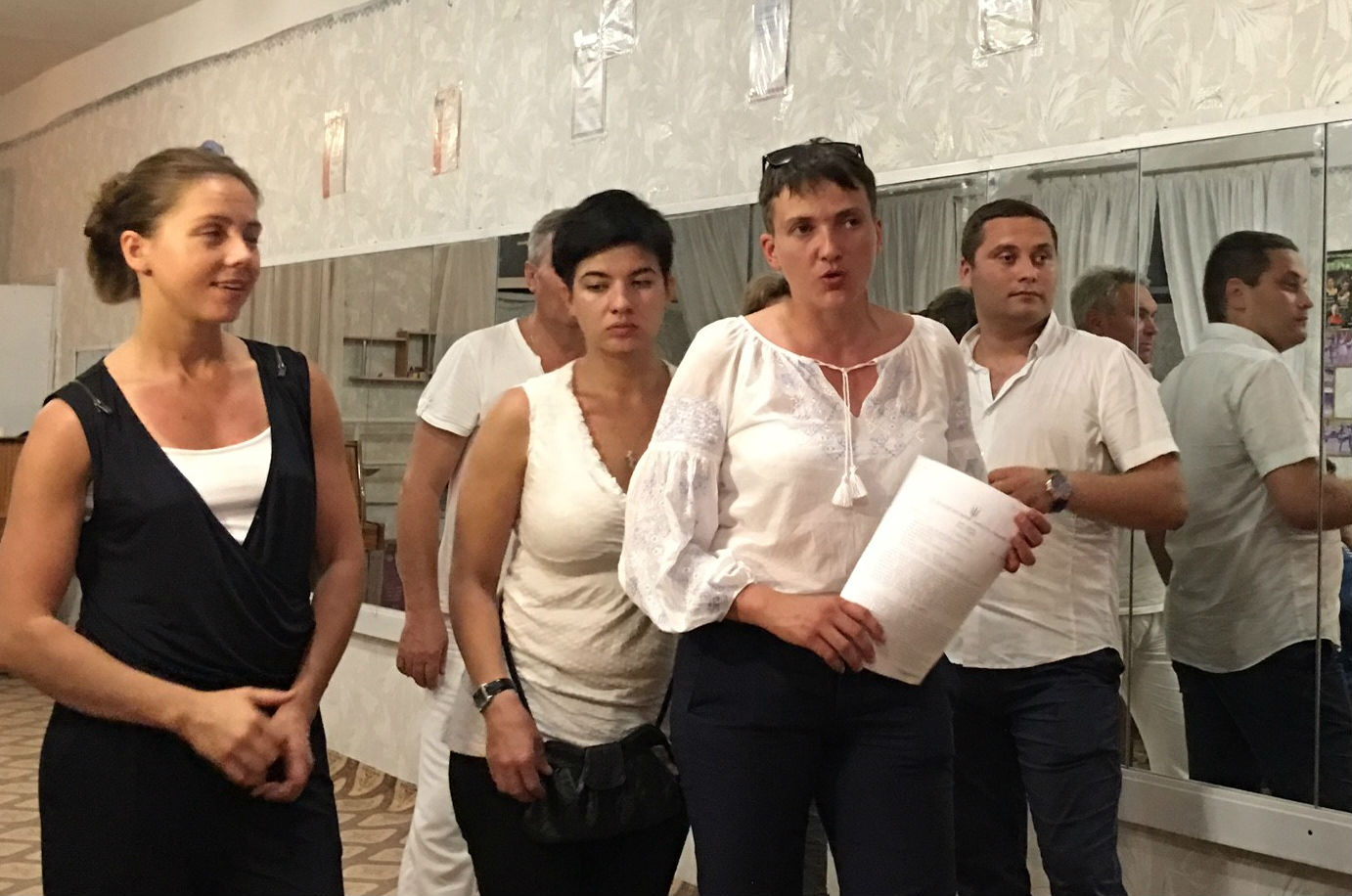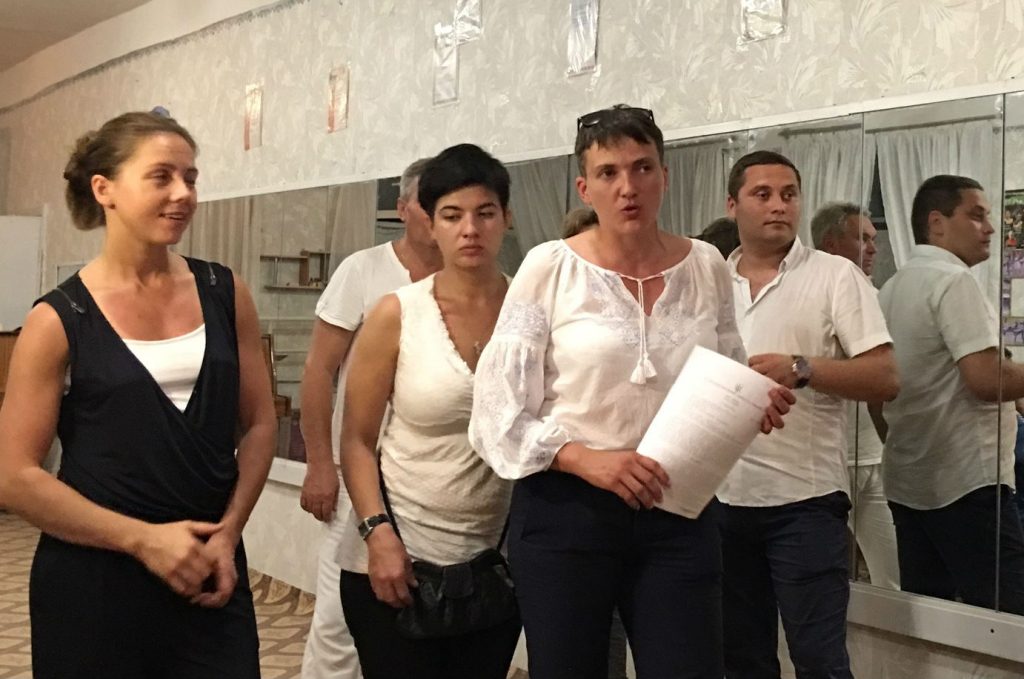
On the eve of Ukraine’s special elections on July 17, Nadiya Savchenko walked into the crowded Stansiya Lughansk district commission offices in eastern Ukraine. She was there to campaign for Fatherland’s Iryna Verihina, who had been Luhansk’s governor for about six months before being replaced. Catching sight of Serhiy Shakhov, a candidate for Nash Krai (Our Land), arguing with the Fatherland commissioner, Savchenko demanded that he identify himself. After Shakhov identified himself as a candidate for parliament, she asked what he was doing there and why he wasn’t fighting in the east with the real men.
Savchenko is Ukraine’s most trusted politician, but this was her first real intervention into retail politics and she seemed authentically repulsed by the workings of the electoral process in Ukraine. To the delight of the television cameras and gathered journalists, Savchenko denounced the process as irrevocably flawed in a series of characteristically fiery appearances outside of the district election office. She later told me that she expected to write her own election law and that she herself was a “one term MP” with no interest in contesting a second term.
Savchenko would not be the first observer of Ukraine’s elections to conclude that the process requires a drastic dose of professionalization. Indeed, reforming Ukraine’s deeply flawed election system might be a Herculean task that can be accomplished only by a belligerent saint.
Ukraine’s special elections were held to fill seats vacated by MPs who had been elevated into the cabinet when Prime Minister Volodymyr Groisman took over in April. It also included an election to replace businessman Ihor Yeremeyev, the head of the People’s Will faction, after his untimely death in an equestrian accident.
Of the elections that took place in seven districts across Ukraine, the most interesting and colorful by far was the one held in the Stansiya Lughansk district; the district’s previous representative, Yuri Harbuz, had been selected to be governor of the oblast.
I took part in the Committee for Open Democracy’s delegation of international election observers to Stansiya Lughansk. We set forth to the district from Slovyansk and driving to the polling station, we passed through numerous armed checkpoints and past heavy weapons camouflaged along the destroyed side roads. The atmosphere outside of the district election headquarters was thoroughly militarized: policemen, militia, interior ministry troops, Ukrainian volunteer battalions, and regular army men milled about with guns in hand.
Parts of the district’s border under separatist occupation, as well as the southern part of the district, experience significant shelling most weekends. Russian-backed separatists held their fire during the elections, but would unleash a barrage the day after, plunging eastern Ukraine back to the edge of open warfare by the middle of the week.
At 6:45 on the morning of the election, several hundred district commissioners were substituted, on orders from party leaders, with commissioners imported from Odesa and Zaporizhya. This was an irregular move if technically legal, suggesting that several major parties did not trust their own representatives.
With no incumbent, the race was wide open, and a record 107 candidates registered to participate. Dozens of false, so-called technical candidates were inserted into the ballot with the intent of confusing voters to split the vote.
With the district’s rural demographics and a large number of registered voters being currently displaced (internally displaced persons cannot vote even by mail or proxy), turnout was middling. The contestation and maneuvering over the final vote count delayed the final results.
The Committee for Open Democracy pronounced the elections to have had widespread shortcomings, but declared that the nominal will of the people seemed to have been recognized.
“The very fact that a district that shares a northern border with Russia and a southern border with occupied Ukrainian territory was able to hold a free election is a victory for Ukraine’s democratic development,” said Brian Mefford, executive director of the Committee for Open Democracy.
These special elections served as symbolic test of the mood toward the government. While the Poroshenko’s Bloc lost five of seven races, two of the independent candidates who won look set to join the president’s faction. Candidates backed by Yulia Tymoshenko and oligarch Ihor Kolomoyskyi were the overall winners. That the Opposition Bloc did not sweep this difficult oblast was positive new for Kyiv.
By the middle of the week in Stansiya Luhansk, it had become obvious that Nash Krai’s Shakhov had won with a tremendous margin. Nash Krai is one of several successor parties to Yanukovych’s disbanded Party of Regions, but one which keeps close ties to the government.
Savchenko’s presence did little to help her candidate, whose final vote count was below those of the top finishers.
Vladislav Davidzon is chief editor of The Odessa Review and Tablet Magazine’s European culture critic. He has reported widely from Eastern Europe, France, and Ukraine, and was previously Ukraine Today’s Paris correspondent.
Image: MP Nadiya Savchenko (center) walks into crowded Stansiya Lughansk district commission offices in eastern Ukraine on July 17. Credit: Brian Mefford
